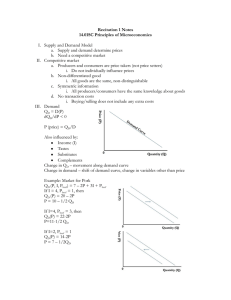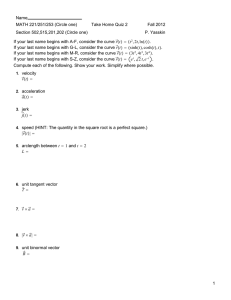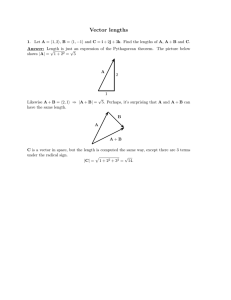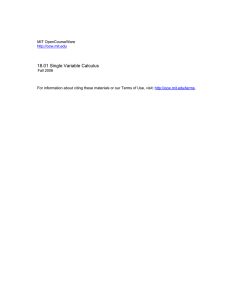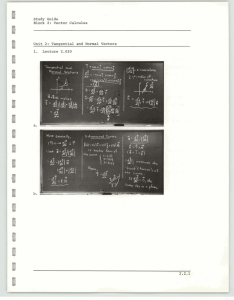Document 13650766
advertisement
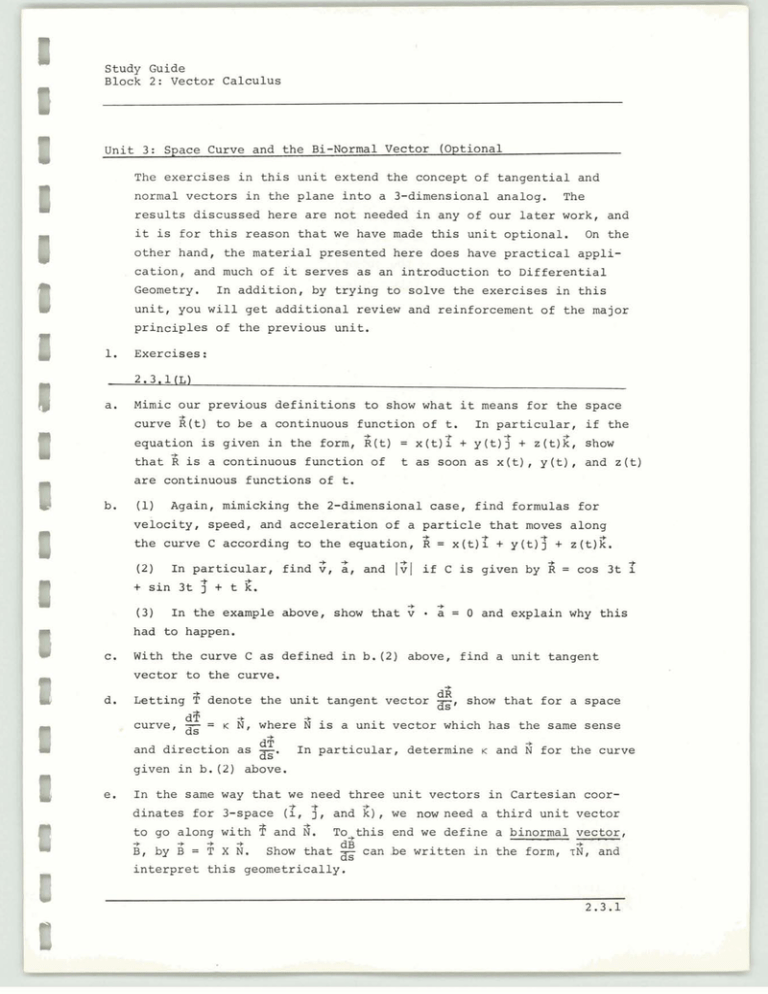
Study Guide Block 2: Vector C a l c u l u s U n i t 3 : Space Curve and t h e Bi-Normal Vector ( O p t i o n a l The e x e r c i s e s i n t h i s u n i t e x t e n d t h e c o n c e p t of t a n g e n t i a l and normal v e c t o r s i n t h e p l a n e i n t o a 3-dimensional analog. The r e s u l t s d i s c u s s e d h e r e a r e n o t needed i n any of o u r l a t e r work, and it i s f o r t h i s r e a s o n t h a t w e have made t h i s u n i t o p t i o n a l . On t h e o t h e r hand, t h e m a t e r i a l p r e s e n t e d h e r e does have p r a c t i c a l a p p l i c a t i o n , and much of i t s e r v e s a s an i n t r o d u c t i o n t o D i f f e r e n t i a l Geometry. I n a d d i t i o n , by t r y i n g t o s o l v e t h e e x e r c i s e s i n t h i s u n i t , you w i l l g e t a d d i t i o n a l review and r e i n f o r c e m e n t o f t h e major p r i n c i p l e s of t h e p r e v i o u s u n i t . 1. Exercises : a. Mimic o u r p r e v i o u s d e f i n i t i o n s t o show what i t means f o r t h e s p a c e curve 6(t) t o be a c o n t i n u o u s f u n c t i o n o f t. -+ e q u a t i o n i s g i v e n i n t h e form, R ( t ) = x ( t ) f t h a t ifR i s a c o n t i n u o u s f u n c t i o n of a r e c o n t i n u o u s f u n c t i o n s o f t. b. In particular, i f the + y ( t ) 3+ z ( t ) < , show t a s soon a s x ( t ) , y ( t ) , and z ( t ) (1) Again, mimicking t h e 2-dimensional c a s e , f i n d formulas f o r v e i o c i t ~ ,s p e e d , and a c c e l e r a t i o n o f a p a r t i c l e t h a t moves a l o n g -+ t h e c u r v e C a c c o r d i n g t o t h e e q u a t i o n , R = x ( t )f -+ + c. -+ I n p a r t i c u l a r , f i n d v , a, and sin 3t j+ t (2) z. (21 + y ( t ) ?+ z ( t ) % . i f C i s g i v e n by 5 = cos 3 t ( 3 ) I n the example above, show t h a t had t o happen, 2 With t h e c u r v e C a s d e f i n e d i n b . ( 2 ) above, f i n d a u n i t t a n g e n t 1 = 0 and e x p l a i n why t h i s v e c t o r t o t h e curve. 3. -+ L e t t i n g T denote t h e u n i t tangent v e c t o r , c u r v e , dP az -- K 8, 8 where =. and d i r e c t i o n a s d? dii z, show t h a t f o r a space i s a u n i t v e c t o r which h a s t h e same s e n s e I n p a r t i c u l a r , d e t e r m i n e r and 8 f o r t h e curve given i n b. ( 2 ) above. e. I n t h e same way t h a t w e need t h r e e u n i t v e c t o r s i n C a r t e s i a n coort j+k), w e now need a t h i r d u n i t v e c t o r t o go a l o n g w i t h 9 and 8. To-+this end w e d e f i n e a binormal v e c t o r , -+ -+ -+ -+ dB B , by B = T X N. Show t h a t can .be w r i t t e n i n t h e form, rb, and i n t e r p r e t t h i s geometrically. d i n a t e s f o r 3-space (1, 3 , and , Study Guide Block 2: Vector Calculus Unit 3: Space Curve and t h e Bi-Normal Vector (Optional) +. 8 , . 1v x a1 a. Show t h a t t h e formula b. Given t h e curve 3 = t: which i s perpendicular t o K = a p p l i e s t o 3-space a l s o . T + 2 t 2 3 + t3z, 8 f i n d t h e equation of t h e plane a t t h e p o i n t corresponding t o t = 1. c. Compute t h e c u r v a t u r e of t h e above curve a t t = 1. d. Express 5 and 8 f o r t h i s same curve a t t = 1. Our space geometry now i n c l u d e s t h e formulas: d 8 = ~ 8 . Complete t h i s l i s t by computing :d =. dli = I,d$ = r8, and 2.3.4 i s given i n t h e form 8 = %(s)where s denotes a r c l e n g t h . 2+ d38 + + Compute z, and i n t e r m s of 3, N, and B. ds ds A curve a. b. ds - - From a. compute t o f i n d t h e formula f o r .r. . a. Use b. t o f i n d formulas f o r 8 = x ( s ) f + y ( s ) )+ z(s)Z. and T i f 3 is expressed i n t h e form Assume 3 i s given a s a f u n c t i o n of time, t , r a t h e r than of a r c l e n g t h s. Mimic t h e d i s c u s s i o n on E x e r c i s e 2.2.4 t o show t h a t (continued on n e x t page) 2.3.2 K Study Guide Block 3: Vector C a l c u l u s U n i t 3 : Space Curve and t h e Bi-Normal Vector ( O p t i o n a l ) 2.3.5 b. continued + Compute j - t l f o r t h e c u r v e R = tl + 2-t 2t 3 + 3+ t k a t t = 1. MIT OpenCourseWare http://ocw.mit.edu Resource: Calculus Revisited: Multivariable Calculus Prof. Herbert Gross The following may not correspond to a particular course on MIT OpenCourseWare, but has been provided by the author as an individual learning resource. For information about citing these materials or our Terms of Use, visit: http://ocw.mit.edu/terms.

